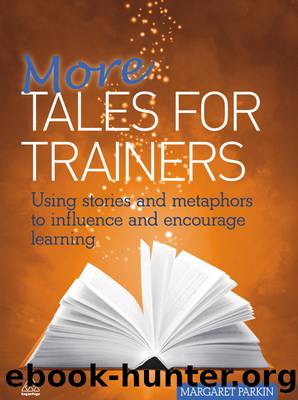More Tales for Trainers by Parkin Margaret;

Author:Parkin, Margaret;
Language: eng
Format: epub
Publisher: Kogan Page, Limited
Whenever you use a pause, do ensure that, from your audienceâs point of view, it is worth the wait; if the outcome doesnât match the drama that you have attempted to create, you will cause disappointment as well as losing rapport.
You can also change the mood and pace of your story by changing the pace of your voice. Make sure that you speak slowly and clearly enough for your words to be heard, but not so slowly that your audience becomes bored. If you are describing something that happened very sâlâoâwâlây or you are reaching the end of the story, you can of course use your voice to reinforce the action of the narrative or stress the importance of the end line. Be careful, though, not to drop the volume or tone of your voice at the end or climax of the piece so that your audience is left wondering and asking each other, âWhat did she say?â This can destroy the whole atmosphere and leave people feeling annoyed that they have sat expectantly for 10 minutes only to have missed the whole point of the story. If youâd like to hear some audio examples of my own storytelling, visit the Kogan Page website at: www.koganpage.com.
Non-verbal communication
An old adage in storytelling is âShow, donât tell.â In other words, your body and facial expression should always be congruent with the tale you are telling, unless you are very obviously being sarcastic or ironic. If itâs a happy story, look happy; if itâs sad, look sad; if itâs dramatic, look dramatic (within reason). Above all, appear confident â if you look unsure, your audience will pick this up and react to your embarrassment.
Use gestures and posture to add further impact to the key elements of your story. For example, when I come to the section of âThe goose that laid the golden eggsâ in which âthe farmerâs wife looked at the egg, looked at the goose and looked at the farmerâ, I look to various parts of the room to reinforce each part of the sentence. When Carly Read told her story about Ann (see âCarlyâs storyâ in Part 2), the indolent worker who had âher evening newspaper semi-hidden in her desk drawer, which she would deftly elbow shut whenever I passed by her officeâ, she quite naturally imitated the action by using her elbows to close the mock drawers that she was describing â a gesture that stuck in my mind for some time after the telling. Jack Maguire (1998) gives good advice on the use of body language in storytelling:
Donât strain yourself to create physical images or moves that donât suggest themselves naturally ⦠if youâre not very expressive with your face or body in everyday life, then youâre very likely to feel and look weird morphing into a mime to deliver a story.
Above all, your storytelling should look and sound like you, not a copy of someone else. You want to adopt a style that you feel comfortable with and that you and your audience can trust and enjoy.
Download
This site does not store any files on its server. We only index and link to content provided by other sites. Please contact the content providers to delete copyright contents if any and email us, we'll remove relevant links or contents immediately.
Hit Refresh by Satya Nadella(8346)
The Compound Effect by Darren Hardy(7576)
Change Your Questions, Change Your Life by Marilee Adams(6658)
Nudge - Improving Decisions about Health, Wealth, and Happiness by Thaler Sunstein(6644)
The Black Swan by Nassim Nicholas Taleb(6205)
Daring Greatly by Brene Brown(5652)
Deep Work by Cal Newport(5501)
Principles: Life and Work by Ray Dalio(5335)
Rich Dad Poor Dad by Robert T. Kiyosaki(5167)
The Myth of the Strong Leader by Archie Brown(4796)
Man-made Catastrophes and Risk Information Concealment by Dmitry Chernov & Didier Sornette(4749)
Big Magic: Creative Living Beyond Fear by Elizabeth Gilbert(4736)
The Slight Edge by Jeff Olson(4729)
Discipline Equals Freedom by Jocko Willink(4642)
Digital Minimalism by Cal Newport;(4569)
The Motivation Myth by Jeff Haden(4536)
Stone's Rules by Roger Stone(4423)
Management Strategies for the Cloud Revolution: How Cloud Computing Is Transforming Business and Why You Can't Afford to Be Left Behind by Charles Babcock(4136)
The Doodle Revolution by Sunni Brown(4051)
